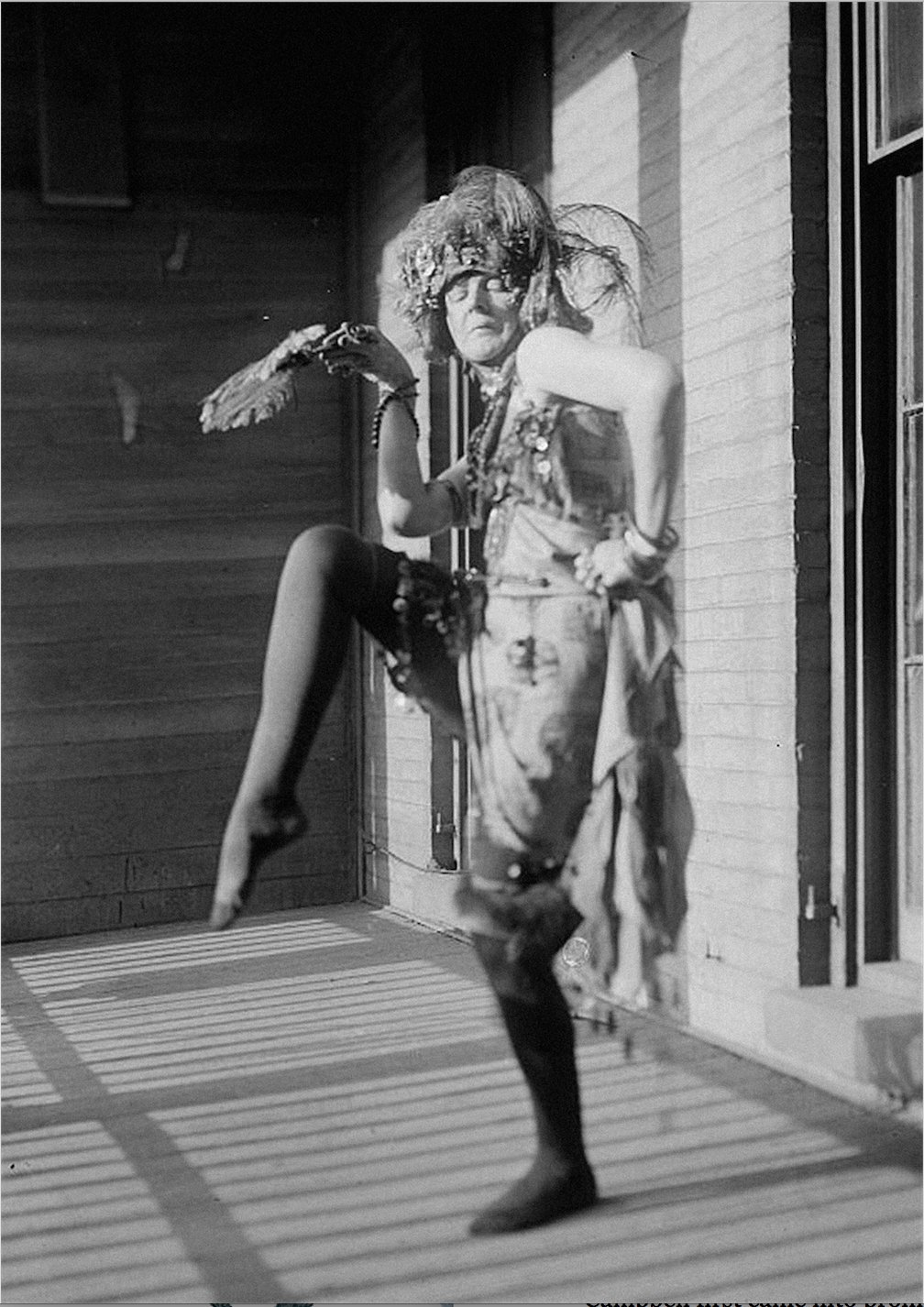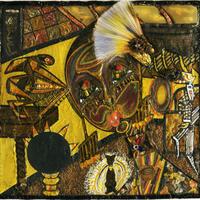More about Elsa von Freytag-Loringhoven
Works by Elsa von Freytag-Loringhoven

Contributor
There is very little explanation for the vast array of eccentricities that characterize Elsa von Freytag-Loringhoven, so we are just going to assume that she was an alien.
First let’s start with her beginning and see if there are any clues there as to why she was the way she was. Elsa Hildegard Ploetz was born in 1874 in what was then Swinemunde, Germany but what is now Świnoujście, Poland. She was the oldest of three children. Her mother was kind and loving but died of uterine cancer when Elsa was nineteen. Her father was in a word...not. He was physically abusive and after her mother died, and there was an incident with him that made her decide to run away. She stated, “My father... behaved so unspeakably, pitifully ridiculous that I felt an overpowering nausea." Her plan of action was to go to Berlin and live with one of her aunts. It was there that she found vaudeville theater and her cross-dressing boyfriend, Melchior Lechter. She began to map out her bisexuality and gender fluidity, while modeling for artists and working as a chorus girl and waitress in order to support herself. She did end up in the hospital with with syphilis, though. The disease was treatable, but the memories would last a lifetime.
Her next move was to Munich, where she began taking art lessons. Unfortunately the lessons were sidetracked when she met and married the architect, August Endell in 1901. They were in an open relationship so naturally Elsa decided that she would get with Edell’s friend, Felix Paul Greve. It turned out that Greve wasn’t so great with the finances and he was in severe debt. But instead of slowly paying it off over the years like a normal person, he, with Elsa’s help, staged his suicide in 1909 and fled to Kentucky, where the couple ran a small farm. Farm life, for Greve, was a lot like severe debt. He just didn’t like it and fled to Canada, this time without Elsa. Elsa made do modeling for artists again despite the fact that she spoke very little English. Eventually she made it to New York, where she would blossom into the alien that she was.
While in New York in 1913, Elsa met and married the German Baron Leo von Freytag-Loringhoven, making her Baroness Elsa von Freytag-Loringhoven – a name I’d say suits her well. Leo left her and went back to Germany right before the start of World War I. He ended up as a prisoner of war and ultimately killed himself. In order to make money after her husband’s death, Elsa was an artist’s model again, but this time for Dadaists like Man Ray and Marcel Duchamp. She starred in a film by them titled "Baroness Elsa von Freytag-Loringhoven Shaves Her Pubic Hair," which is self-explanatory. Over the course of her modeling, Elsa developed an infatuation with Duchamp. He was decidedly not down but said that, “She is not a futurist. She is the future.” Meanwhile Elsa was doing performances that “consisted of her rubbing a newspaper article about the artist's famous painting Nude Descending a Staircase (1912) over her naked body and then reciting a poem that ended, ‘Marcel, Marcel, I love you like Hell, Marcel.’” Not the smoothest approach, but A+ for effort!
It’s also possible that that whole ‘readymade’ thing was Elsa’s concoction and she was in fact the artist behind Duchamp’s famous Fountain. In a letter to his sister Duchamp wrote, “‘one of my female friends under a masculine pseudonym, Richard Mutt, sent in a porcelain urinal as a sculpture.’" R. Mutt can be interpreted as a homonym for armut, meaning ‘poverty’ in German – something the baroness was highly familiar with.
Elsa didn’t just make Dada art. Rather, she lived Dada art. Her wardrobe often consisted of things like, “a tin-can bra, a birdcage (with live bird) for a hat, curtain rings as bangles, and an assortment of feathers and tassels,” all worn while having “her five stray dogs trailing behind her on a gilded leash.” She once painted her shaved head red and said “it was 'like having a new love experience.'” Often times she would carry around a large plaster penis in order to shock all the little old ladies walking by. Her wardrobes were the perfect combination of self-made and store-stolen. She was arrested several time for stealing but “was so regal when stepping out of the back of the paddy wagon that the police usually looked on in wonder and let her go.” She even at one point got into a fistfight with the poet William Carlos Williams. He had said that he was in love with her so, naturally, she ambushed him at his home in New Jersey despite the fact that he was married. Williams then took up boxing to defend himself from her, eand it all ended in a brawl in the streets of Manhattan.
Shockingly enough, none of this made the Baroness any money and she lived in abject poverty. She was planning on starting a modeling school in Paris when either by suicide, murder, or accident, Elsa and her pets died of asphyxiation on December 14, 1927. Elsa claimed that, “every artist is crazy with respect to ordinary life," but she definitely took (and at one point wore) the cake.
Sources
- Cotter, Holland. "The Mama Of Dada." Nytimes.com. N.p., 2002. Web. 10 Apr. 2018.
- Higgs, John. "Who Actually Created Marcel Duchamp's 'Fountain'?." The Independent. N.p., 2015. Web. 10 Apr. 2018.
- Hillegas, Laura. "Baroness Elsa Von Freytag-Loringhoven Biography, Art, And Analysis Of Works." The Art Story. N.p., 2018. Web. 10 Apr. 2018.
- Oisteanu, Valery. "Artnet.Com Magazine Features - The Dada Baroness." Artnet.com. N.p., 2002. Web. 10 Apr. 2018.
- Steinke, René. "My Heart Belongs To Dada." Nytimes.com. N.p., 2002. Web. 10 Apr. 2018.
Featured Content
Here is what Wikipedia says about Elsa von Freytag-Loringhoven
Elsa Baroness von Freytag-Loringhoven (née Else Hildegard Plötz; 12 July 1874 – 14 December 1927) was a German avant-garde visual artist and poet, who was active in Greenwich Village, New York, from 1913 to 1923, where her radical self-displays came to embody a living Dada. She was considered one of the most controversial and radical women artists of the era.
Her provocative poetry was published posthumously in 2011 in Body Sweats: The Uncensored Writings of Elsa von Freytag-Loringhoven. The New York Times praised the book as one of the notable art books of 2011.
Check out the full Wikipedia article about Elsa von Freytag-Loringhoven











